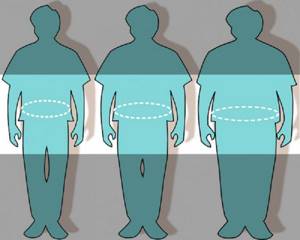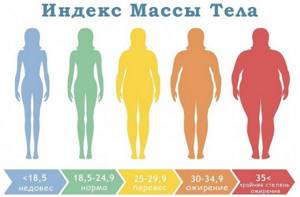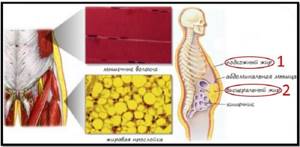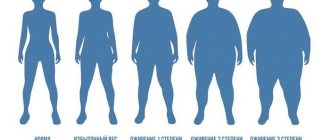The types of obesity depend on certain factors that need to be classified. Classification of types of excess weight - development of research centers, institutes and laboratories in different countries. WHO is concerned about the problem of excess weight and calls it “an epidemic of the 21st century.” To successfully treat a patient with obesity, it is necessary to first determine its type.
Classification of obesity types:
- For the reasons for the formation of the disease;
- According to the characteristics of adipose tissue;
- According to the location of fat deposits on the body;
- According to the stages of the disease.
Why does female-type obesity develop?
Normally, men maintain balanced levels of androgens and estrogen. Testosterone predominates, responsible for the formation of muscles, broad shoulders, narrow hips. Estrogen, although present in the body, does not have a noticeable effect on the formation of adipose tissue and body type.
A completely different picture emerges if, during a hormonal imbalance, the level of estrogen prevails over the amount of testosterone. In this case, the body reacts accordingly, potency decreases, and fat is deposited on the hips and buttocks. Often fatty tissues also develop in the chest area. Therefore, doctors believe that the main reason for the development of obesity in men according to the female type is a disruption in the functioning of the endocrine system.

By the way, in adolescence, boys undergo a restructuring of their bodies. At the age of 10-15 years, hormonal imbalance is not uncommon, so adolescents may experience gynoid obesity. As a rule, the pathology goes away with age.
Other possible causes of the pathology:
- eating disorder;
- mental disorders;
- sedentary lifestyle;
- ecological situation.
Doctors note that heredity also plays a role. If parents have female obesity, then the child’s likelihood of developing a similar pathology increases.
Due to the formation
Based on the reasons for its formation, the disease is divided into two types – primary and secondary. Primary is understood as eating disorders, and secondary is all the others caused by genetic predisposition or concomitant diseases.
Primary
The primary type is also called “sugar” and is the result of an unhealthy lifestyle and nutritional disorders. What happens is that you consume more calories than your body can burn, so the excess calories turn into body fat. But there is no way to eat less. And these are not bad habits, but addiction. What happens to a person is called “eating disorders”; it is not bad behavior, but a disease that has its roots in the emotional sphere.
Eating disorders or addictions are always caused by psycho-emotional stress, which indicates quite serious problems in a person’s psycho-emotional state.

The sugar type is not taken seriously; it is supposedly easier to deal with than smoking or alcohol addiction. But is this really so? Of course not. It is even customary to laugh at excess weight, as if it were not a disease at all, but just a set of bad habits. But in fact, the opposite is true - eating disorders cause personality changes.
Although the nutritional type of the disease does not manifest itself immediately and does not cause such harm as drug addiction or gambling addiction, it also has powerful emotional anchors.
A person gets used to the fact that after stress, the only way to relieve stress is food. Nothing else helps relieve tension. Every time you quarrel with a colleague or lose your keys, the resulting stress awakens your appetite and secretes gastric juice and saliva. And so on at the slightest trouble. Who doesn't get into trouble? It follows that excess weight due to eating disorders must be dealt with on the same basis as addictions, and there is no shame in seeking help from specialists.
At first, eating disorders may not be much of a concern, but the advanced stage of the disease becomes truly life-threatening. Therefore, eating disorders must be treated immediately, without shelving and without relying on the Russian “Maybe”!
Secondary
In the case of secondary obesity, patients are diagnosed with the presence of some other disease; its symptom is excess body weight. To identify the presence of a secondary rather than a primary disease, a lot of research may be required. If it is not possible to identify any other ailments other than excess weight, then by exclusion it is classified as primary. Secondary is also called symptomatic and there are five types of it:
- Cerebral or hypothalamic (various brain tumors; consequences of head injuries, infectious diseases or surgery, as well as “empty sella” syndrome). For example, in the pituitary type of disease the cause is a disease of the brain; it is common mainly among young people under 25 years of age.
- Endocrine (changes caused by tumors of the adrenal cortex; pathological decrease in the level of various hormones responsible for metabolism in the body; the onset of menopause in women).
- Due to congenital pathologies (caused by genetic diseases responsible for metabolic energy processes in the body).
- While taking antipsychotics and/or having mental illness.
- Caused by taking medications (medication).

About 25-30% of people worldwide are overweight. Of these, only 5% are classified as secondary obesity, and the remaining 95% suffer from a primary type of disease due to eating disorders.
How is female obesity determined?
When a man consults a doctor, the specialist finds out details about the patient’s lifestyle. You need to feel free to answer questions about the quality of your diet, daily routine, and medication use. The presence of obesity can be calculated by body mass index. The appearance of the figure also indicates a gynoid disease: the deposition of fat on the hips and buttocks makes the figure look like a pear.
Testing for testosterone and estrogen levels will help make an accurate diagnosis. If the predominance of the female sex hormone is revealed, the doctor will be able to confidently say about the development of obesity in a man or teenager according to the female type.

At the final stage of the examination, you will need to do an MRI or ultrasound of the internal organs. This is necessary to determine the presence of visceral fat on organs, its quantity and the degree of organ degeneration.
Having the results of tests and examinations in hand, the doctor will select the appropriate treatment.
Types of obesity according to etiology
If we take into account the origin of the pathology, it can be primary (alimentary) and secondary (symptomatic). Each of the presented types of disease has its own causes.
Nutritional obesity develops due to:
- excessive food consumption;
- low level of physical activity;
- influence of hereditary factors.
When the amount of calories consumed by food exceeds the body's energy expenditure, excess formation of adipose tissue occurs. Under the influence of poor nutrition and physical inactivity, a genetic predisposition may appear.

Many women use food as a way to deal with constant stress, which in turn can disrupt hormone production.
Female obesity of the secondary type is a disease that results from:
- traumatic, infectious or tumor lesion of the hypothalamus;
- hormonal imbalance;
- use of certain medications (glucocorticosteroids, antidepressants, contraceptives).
A common cause of obesity is hormonal imbalances that occur during puberty, pregnancy and menopause.
How is gynoid obesity treated in men?
The principles of treatment for female obesity are the same as for abdominal obesity. Regardless of the reasons that caused the pathology, the fight against it begins with switching to a diet. The following foods are gradually excluded from a man’s diet:
- fried and fatty foods;
- flour products;
- sweets and sugar;
- tea, coffee, juices.
Instead of excluded food products, cereals, fresh vegetables and fruits, and herbs are added. Meat is allowed, but no more than twice a week and preferably dietary, for example, rabbit. Instead of excluded drinks, it is recommended to drink plain water. The volume of liquid consumed daily should not be less than two liters.
Simultaneously with the transition to a therapeutic diet, the lifestyle is adjusted. The doctor recommends that the man spend more time walking, running, and cycling. The best exercises are those that help burn excess fat in problem parts of the body. Daily squats give a good effect. At this stage, it is important for a man to know: visceral (internal) fat is burned first. Therefore, if obesity from the buttocks and thighs does not go away immediately, do not despair.

If diet and lifestyle changes do not help, drug treatment and hormone therapy are carried out. The doctor selects medications that promote weight loss, reduce appetite, and stabilize the psycho-emotional state. At the same time, vitamins and medications that strengthen internal organs are prescribed. For example, if the functioning of the intestines is disrupted, the doctor carries out a course of treatment aimed at normalizing the functioning of the organ.
In stage 3 obesity, in which the body mass index is more than 30, it is not always possible to cope with female-type obesity in men using conservative treatment methods. Therefore, operations are performed to reduce the volume of the stomach.
Types of obesity according to etiology
Taking into account what was the provoking factor in the occurrence of excessive body weight, the following types of excess weight are distinguished:

- Cerebral. A similar condition occurs when tumor, infectious or traumatic damage to certain structures of the brain, pituitary gland, hypothalamus. This type of obesity is called cerebral obesity;
- Nutritional. This type of obesity is the most common. The peak incidence of the nutritional form of pathology occurs in countries with high population density. The reason for the accumulation of excess kilograms is excessive and unbalanced nutrition, as well as consumption of fast food products. Additional factors in the development of nutritional obesity include the habit of getting rid of stress by eating food, eating late (after six in the evening), as well as a hereditary predisposition to metabolic pathologies;
- Medication. This form of the disease is triggered by the use of such groups of drugs as antidepressants, glucocorticosteroids and combined oral contraceptives.
In some sources, this classification of obesity has more points, one of which is excess weight caused by physical inactivity.
What are the consequences without treatment?
If female-type obesity is not treated in men, concomitant diseases develop. First of all, the pathology affects sexual functions. Erectile dysfunction occurs due to poor circulation. And the predominance of estrogen leads to a decrease in libido.
The described type of obesity affects not only potency. Blood flow in the pulmonary circulation is disrupted. This affects the functioning of the lungs and heart. Shortness of breath appears, and the risk of heart attack and stroke increases. In female obesity, the liver is affected. The organ becomes overgrown with visceral fat, increases in size, and its function is impaired.

Starting from the second degree of obesity, dystrophic changes occur in the bones and tendons. First of all, this affects the spine. Pain occurs and mobility decreases. Further, the pathology extends to the joints of the limbs. In men, they begin to hurt for no apparent reason, and the pain intensifies with minor physical exertion.
Principles of nutrition and lifestyle for male obesity
Reviewing your daily diet is an important point on the path to getting rid of extra pounds. For female obesity, fat reserves need to be removed from the buttocks, thighs, and abdomen. The fact is that it is not subcutaneous fat that is broken down first, but visceral fat, which envelops the abdominal organs and increases the volume of the abdomen.
Training at the beginning of obesity therapy may not give the desired result; you need to choose a food basket that will return the nutritional balance to normal:
- Floury, sweet, and fatty foods should be excluded from the daily menu and replaced with lean meats and fish;
- Enrich the table with cereal ingredients, herbs and vegetables;
- You cannot refuse fermented milk products, choosing products with low fat content;
- To start the mechanism for breaking down excess fat, you need to reduce the amount of carbohydrates from outside and reduce the calorie content of your daily diet. A nutritionist or endocrinologist will help you understand this issue;
- Drink 2 liters of clean water to reduce hunger and normalize water-salt balance. This is important for metabolic rate;
- Forget about random snacks and missed breakfasts, lunches, dinners. Meals should be frequent, fractional, with the maximum amount of calories in the first half of the day.
After adjusting your diet, you can think about working out or walking for an hour to tidy up not only your digestive processes, but also strengthen your body’s muscular frame. Increase the loads gradually and at the initial stage trust professionals who will select a program appropriate to the man’s age, general well-being and desired result.
The support of loved ones is important in this matter. Even strong men need care and attention, especially when it comes to health.
In modern society, the principle of a healthy lifestyle is actively promoted and the conditions for proper weight loss have been created. You just need to agree that there is a cause for obesity and take active steps to eliminate this problem.
Let's sum it up
Obviously, female obesity in men brings a number of problems. This is the development of psychological complexes, due to the appearance of an effeminate figure and a decrease in potency. And the risk of developing diseases, including cardiovascular diseases. Therefore, treatment must begin at the first stage. Even better - at the first signs of excess weight. Then you can avoid unpleasant consequences for the body and not resort to surgical treatment methods.
To prevent female obesity, a man needs to watch his diet and move more. Try not to abuse beer, which contains the female sex hormone estrogen. Following these recommendations will help prevent the problem from occurring and improve your quality of life.
According to the characteristics of fat deposits
Fat cells are called adipocytes. With obesity they change; their changes can be quantitative, qualitative or mixed. Based on the morphological characteristics of fat deposits, three types of obesity are distinguished:
- Hyperplastic (the number of fat cells increases);
- Hypertrophic (the size of fat cells increases);
- Mixed (both the number and size of cells grow at the same time).
In childhood and adolescence, the disease proceeds according to the hyperplastic type. In children, the amount of adipose tissue increases due to the appearance of a large number of new fat cells. With this type of excess weight, it will be quite difficult to burn excess fat.
In adults, on the contrary, hypertrophic obesity is observed, in which the cells themselves grow, and not their total number. In patients with significant excess weight, symptoms are expressed: fatigue, headaches and various body aches, gastrointestinal disorders, insomnia.
Critical 4th degree
The most critical condition. This degree is characterized by excess weight twice or more. This stage is rare, as obese people simply do not live to reach it.
They cannot move - they only lie on the bed and sit, changing their position with someone's help. Shortness of breath torments them even at rest. And the body with the fourth degree of obesity resembles a shapeless mountain of fat. BMI, of course, is not calculated in such cases - it simply exceeds all acceptable standards.
There are cases where people with this degree of obesity have lost a lot of weight. Above is a photo of a British man named Paul Mason. He once went down in history as the fattest man on the planet. In 2013, he weighed 445 kilograms! It was the 4th type of obesity that the man had at that time. Paul said he was a prisoner of food. Every day I consumed kilograms of food.
But one day Paul fell in love with a woman from America who wrote to him after reading a story about him in the media. He decided to lose weight to be with her. And he achieved it! Two long years of daily exhausting training, special diets, and Paul lost as much as 300 kilograms! The consequence was whole layers of sagging, stretched skin. It had to be removed. The operation lasted 9 hours. Paul had 21 kilograms of excess skin removed.
So it’s possible to lose weight, even if you weigh almost half a ton, but it’s absolutely not recommended to go that far. There will be consequences, and they will cause irreparable harm to the body.
Prevention
In industrialized countries, a third of the population is susceptible to developing obesity. Therefore, you need to know how to prevent this unpleasant disease.
Among the preventive measures, experts recommend the following:
- Maintaining a low-calorie, balanced diet with restrictions on flour, sweets, fried, fatty, and salty foods. Eat a large amount of vegetables (300 g per day) with minimal heat treatment, as well as low-calorie fruits. The daily diet is divided into 5 meals: 25% breakfast, 10% snack, 35% lunch, 10% afternoon snack, 20% dinner.
- Active lifestyle. Regular physical exercise (at least 3 times a week).
- Massage (manual, hardware, underwater shower-massage) of the gluteal-femoral area.
Nutritionists from the USA advise to prevent weight gain by eating seasonings, and in particular curry, which contains curcumin, which helps reduce the concentration of cholesterol in the human body.
The prevention of obesity is also facilitated by good spirits, good mood and avoidance of stressful situations.
But both in the treatment and prevention of this pathology, there is no need to “go too far”: excessive physical exertion and malnutrition should not be allowed. Because in this case, even if a decrease in body weight occurs, the general condition of the body will worsen due to a lack of vital substances.
Currently, obesity is a very common serious disease that negatively affects a person’s quality of life, health status and life expectancy. This means that you need to take the issue of treatment and prevention of the disease seriously.
source
First degree manifestation
Least critical condition. Often occurs in childhood. For obesity type 1 (degree), the following BMI corresponds:
- From 28 to 30.9 for people over 25 years old.
- From 27.5 to 29.9 for those aged 18 to 25.
If you carry out simple calculations, you can understand that the first degree of obesity is height in centimeters, from which 100 is subtracted and 15 is added. Here, for example: BMI = 85 kg: (1.7mx1.7m) = 29.4. For clarity, rounded weight and height figures were taken.
So the maximum excess at the first degree is approximately 15 kg.










